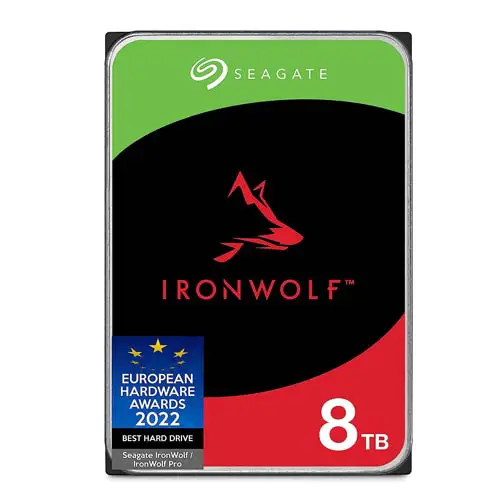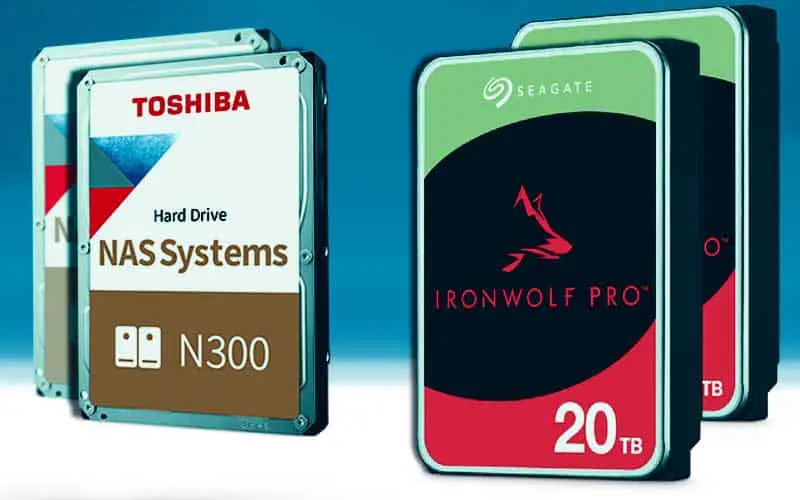Both NAS drives have equivalent maximum storage capacity, and are compatible with multimedia servers allowing multiple users to perform numerous tasks simultaneously.
Both support up to 8 expansion adds-on and minimize the vibration sounds by built-in RV sensors.
The Toshiba N300 supports exceptional reliability for NAS and other high-performance storage systems. It supports the high-capacity storage for individual, home office, and small-scale business use.
The device has an increased actual time performance. Its helium-sealed design consumes low power along with increased storage density.
The Seagate device on the other hand, the Ironwolf, delivers competitive, instant and accessible performance in NAS and multi-bay networked environments along with a broad range of data storage capacities.
The Ironwolf Health Management increases the system reliability. It also comes along with a data recovery plan in case of an unexpected data exploitation
Table of Contents
Comparing Both Devices
Compared to Seagate Ironwolf, the Toshiba N300 has a superior data transfer rate, lower power consumption, improved helium design for all sizes, better durability, minimal heat production, and compatibility with multi-RAID systems whereas its contender takes the lead in cost-effectiveness, weight, and size diversity.


| Technical Specifications | N300 | Ironwolf |
| Device type | NAS (Network Attached Storage) Hard Drive | NAS (Network Attached Storage) Hard Drive |
| Interface | SATA 6Gb/s | SATA 6Gb/s |
| Form Factor | 3.5 inches | 3.5 inches |
| Drive Bays Supported | 1-8 Bays | 1-8 Bays |
| Rotational Vibration (RV) Sensors | Yes | Yes (4TB- 18TB) No (1TB-3TB) |
| Workload Rate Limit (WRL) | 180 | 180 |
| Unrecoverable Error Rate (bits read) | 4 TB = 1 per 1015 | 4TB = 1 per 10E14 |
| Limited Warranty (years) | 3 | 3 |
| Supply voltage | 4TB = 5V (±5%), 12V (±10%) | 4TB = 5V (±5%), 12V (±10%) |
| Acoustics (idle mode) in decibels (dB) | 4TB 31 | 4TB 23 |
| Drive design | Helium | 18TB-12TB, 10TB = Helium 10TB-1TB = Air |
Applications of Toshiba N300:
- Network Attached Storage (NAS)
- Desktop raid and servers.
- Compatible with multimedia server storage.
- Private cloud storage.
- Small scale business server and storage.
Applications of Seagate IronWolf:
- Consumer and comercial NAS.
- Desktop workstations.
- Multimedia servers.
Features of Toshiba N300
- It allows streaming, backing, and archiving of data due to the support of modern data storage.
- It is compatible with a multi-raid system that enhances the process of data storage, access, and protection.
- Advanced RV sensors minimize the impact of vibrations.
- It is a multi-functioning device allowing access to multiple users at multiple locations simultaneously.
- It is highly reliable which makes it 3 times more convenient than other HDDs. Additionally, it supports a workload of 180TB/year.
- It is composed of highly endured mechanisms ensuring better durability.
- It automatically controls the browsing speed which helps in minimizing heat generation.
- It has a special region to temporarily store data called a data buffer which allows fast data retrieving speed and makes the drive more compatible with small-scale businesses.
- Allocation of cache during the read/write operations is optimized by Toshiba’s dynamic cache technology.
- Its helium-sealed design consumes low power along with increased storage density.
Features of Seagate IronWolf:
- It is designed for NAS with Agile Array Technology that optimizes system reliability and performance.
- Delivers super RAID performance in multi-bay systems.
- It is a multi-functioning device allowing access to multiple users at multiple locations simultaneously.
- It uses Conventional Magnetic Recording (CMR) technology which is used for data recording on magnetic media, particularly hard disks for stable NAS performance.
- It supports a workload of 180 TB/year allowing effortlessly storing and working with large volumes of networked data.
- It is graded for 1 million hours MTBF with a 3-year limited warranty allowing to store data with peace of mind and exclusive total cost of ownership (TCO).
- Like its competitor, it has built-in RV sensors to minimize the impact of vibration assuring stable performance in multi-bay systems.
- Ironwolf Health Management (IHM) protects your NAS data with precaution, conciliation, and recommendations for retrieval to ensure ultimate system performance.
- Seagate benefits its customers with Rescue Data Recovery Services.
Compare With other devices
How do these Hard Drives differ in Design & Hardware?
The portable NAS hard drives of both the competitors are having a similar design of rectangular disk shape.
Both of them are almost equal in size but Toshiba N300 is comparatively heavier in weight than its competitor.
Toshiba N300 constitutes a helium-sealed design that consumes low power along with increased storage density and reliability.
Helium leads to air in a way that it is seven times lighter than air, consuming 20% less energy than conventional HDD and ensuring an 80% data recovery success rate.
It generates less drag and instability when HDD platters spin.
It prevents humidity from entering inside when sealed.
Seagate Ironwolf lacks behind its contender because its 10TB and 1TB do not constitute helium design.
Another important parameter affecting the life span of the NAS hard drive is the temperature.
The higher temperature increases the risk of failure.
The temperature of the disk varies according to the models but most models have an operating temperature of 5°C to 50°C.
Comparatively, Seagate Ironwolf seems to have a wide operating temperature range of 0 to 65°C, while its contender has a relatively higher temperature range which is not good for the life span of drives.
Both competitors are suitable for small-scale businesses but Ironwolf takes the lead as it also handles professional businesses while its competitor is more suitable for personal homes businesses.
| Parameter | N300 | Ironwolf |
| Dimension in inches (L x W x D) | 4TB = 5.78 x 4.01 x 1.03 | 4TB = 5.787 x 4.01 x 1.028 |
| Weight, 4TB | 693 g | 490 g |
| Temperature (Operating / Non-Operating) | 5 to 65° C / -40 to 70°C | 0 to 65° C / -40 to 70°C |
| Environment | Personal, Home Office, and Small Business | Professionals and Small Businesses |
Which of them has a better Rotational Speed?
The rotational speed is measured in higher revolutions per minute.
It determines the speed at which the platters move inside the hard drive.
Faster spinning makes the data bits move past the read/write head quicker, resulting in higher data rates.
A typical drive having a rotational speed of 7200rpm delivers a comparatively 33% faster data rate than most data drives available in the market.
Both competitors have an exceptional rpm of 7200 which means both have good data transfer rates.
Which has a efficient Power Consumption?
Toshiba N300 consumes comparatively lower power than its competitor which lowers the electricity usage, making it cost-effective, extending the life of the drive, and making it more effective in performance.
| Parameter | N300 | Ironwolf |
| Power Consumption Idle Average (W) | 4TB = 4.04 | 4TB , = 3.96 4TB = 3.95 |
Data Transfer Speed Comparison
N300 has a comparatively higher data transfer speed than its contender. N300 allows the quicker transmission of a given amount of data from one place to another.
| Parameter | N300 | Ironwolf |
| Data transfer speed (MB/s) | 4TB = 232 | 4TB = 202 4TB = 180 |
Differences in Storage Capacity
Toshiba N300 has a storage capacity ranging from 4TB to 18TB while its competitor’s range is 1TB – 18TB.
Both contenders provide equivalent storage capacity but Ironwolf leads its competitor in the way that it has 11 sizes available while N300 has only 8 sizes available.
So Ironwolf wins this competition in terms of product diversity.
| Specification | N300 | Ironwolf |
| Capacity | 4TB, 6TB, 8TB, 10TB, 12TB, 14TB, 16TB, 18TB | 1TB, 2TB, 3TB, 4TB, 6TB, 8TB, 10TB, 12TB, 14TB, 16TB, 18TB |
Considering all of the above
Both competitors;
- have equivalent data storage capacity.
- are designed for NAS (Network Attached Storage) systems.
- are compatible with multimedia systems.
- support 1-8 drive bays.
- workload rate limit of 180.
- have an interface of SATA 6Gb/s.
- offer 3 years of warranty.
N300;
- has superior data transfer rate.
- has lower power consumption.
- constitutes a helium design.
Ironwolf;
- is relatively lighter in weight.
- is relatively less expensive.
- Has 3 additional sizes available in terms of storage capacity.
- some sizes have helium while some have an air-sealed design.
